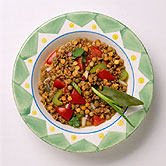
MONDAY, Oct 22 (HealthDay News) — People suffering from type 2 diabetes can see an improvement in both their blood sugar levels and blood pressure if they add beans and other legumes to their diet, Canadian researchers report.
Chickpeas, lentils and beans are rich in protein and fiber, and these may improve heart health. Because they are low on the glycemic index, a measure of sugar in foods, they may also help control diabetes, the researchers explained.
“Legumes, which we always thought were good for the heart, actually are good for the heart in ways we didn’t expect,” said lead researcher Dr. David Jenkins, the Canada Research Chair in Nutrition and Metabolism at the University of Toronto.
Among diabetics, “not only did their glucose control become better, but — and this surprised us — it had a significant effect on blood pressure,” he said.
Exactly why legumes have this effect on blood sugar and blood pressure isn’t known, Jenkins said. The effect is most likely due to the protein, fiber and minerals they include, he noted.
Jenkins recommends adding more legumes to the diet. “They will do well for you,” he said. “They will help you keep your blood pressure down and your blood glucose under control, and help you keep your cholesterol down.”
The report was published online Oct. 22 in the Archives of Internal Medicine.
For the study, Jenkins’s team randomly assigned 121 patients with type 2 diabetes to eat one cup of legumes a day or whole-wheat products.
Over three months, the researchers found that those eating legumes saw an improvement in their blood sugar of 0.5 compared with 0.3 for those eating whole-wheat products. In addition, those eating legumes saw a reduction in blood pressure of 4.5 mm Hg, compared with a reduction of 2.1 mm Hg among those eating whole-wheat products, they found.
These improvements in blood pressure and blood sugar add up to better diabetes control and a reduced risk of cardiovascular disease, the researchers said.
The study was funded in part by the Saskatchewan Pulse Growers, a nonprofit organization representing pulse-crop farmers in Saskatchewan. Pulse crops include chickpeas, lentils, fava beans and soybeans.
Marion Franz, from Nutrition Concepts by Franz Inc., in Minneapolis, and author of an accompanying journal editorial, said “the study clearly shows that legumes are part of a healthy eating pattern.”
Franz noted that patients were able to control blood sugar as well with whole wheat as they did with beans, and it may be easier for people to eat three servings of whole wheat a day rather than a cup of beans a day.
“What’s really important for people with type 2 diabetes is not really what they eat, but how much they eat,” Franz said. “You can overeat on healthy foods too.”
Samantha Heller, an exercise physiologist and clinical nutrition coordinator at the Center for Cancer Care at Griffin Hospital in Derby, Conn., agreed.
“For people with type 2 diabetes, beans as part of an overall healthy diet are a great addition,” Heller said. “Not only do legumes have a relatively low glycemic index, they are loaded with fiber, antioxidants, protein, vitamins and minerals.”
Beans provide a heart-healthy, nutritious and affordable alternative to less healthy red and processed meats, Heller said. Several studies suggest a link between eating legumes and lower incidence of type 2 diabetes, cardiovascular disease and cancers, along with better weight management, she said.
“While people may not eat a full cup of beans daily, as they did in this small study, including beans in a healthy diet will still provide many health benefits,” Heller said. “Beans are great to use in dips, pasta sauce, salads, burritos, soups, stews and even brownies.”
Another expert, who does believe in a low glycemic diet, said patients still need individualized eating plans.
“There is no standard recommendation with a low glycemic diet,” said Dr. Minisha Sood, an endocrinologist at Lenox Hill Hospital in New York City. “It is more beneficial to my patients to tailor diet recommendations.”
Sood said she looks for specific problem areas, such as portion control or snacking. No single diet or food fits all patients.
“Dietary recommendations should be based on a patient’s lifestyle, food likes and dislikes,” she noted. “It really requires in-depth nutritional counseling.”
Although the study found an association between eating legumes and decreased blood sugar and blood pressure, it did not prove a cause-and-effect relationship.
More information
For more information on a healthy diabetic diet, visit the U.S. National Library of Medicine.

